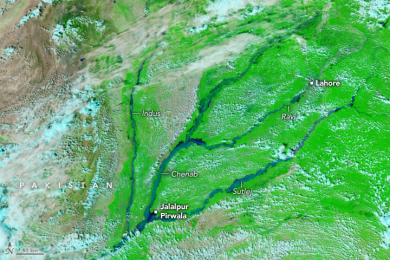Since late June 2025, unusually heavy monsoon rains have led to widespread flooding in Pakistan, claiming hundreds of lives, destroying infrastructure, and submerging large areas of farmland. Millions of people have been affected, with the UN Office for the Coordination of Humanitarian Affairs (OCHA) describing the disaster in eastern Punjab province as the most severe in its history.
Satellite imagery from the VIIRS (Visible Infrared Imaging Radiometer Suite) on the NOAA-20 satellite highlights the scale of the disaster. False-color images acquired on September 9, 2025, show widespread flooding along major rivers in Punjab. A comparison with imagery from the same date in 2023, when monsoon rainfall was near normal, shows significantly less surface water in the area.
In mid-August, intense rainfall in Pakistan’s mountainous northern areas resulted in deadly flash floods and landslides. By late August, rainfall levels had climbed to 21 percent above the national average and 36 percent higher in Punjab province. By September 4, the flooding had affected nearly 4 million people in eastern Punjab, led to around 2 million evacuations, and submerged roughly 4,000 villages.

In Lahore, Pakistan’s second-largest city, floodwaters from the Ravi River swept into residential areas and inundated major roads. Moreover, rising waters from the Chenab River forced authorities to evacuate over 25,000 residents, nearly half of the population, from Jalalpur Pirwala by September 8, after nearby villages had already been engulfed. Further south, evacuations continued in Sindh province from low-lying settlements along the Indus River, preparing for severe flooding. The province’s flat plains remain especially vulnerable, having been among the worst-hit regions during the devastating 2022 monsoon floods.
The impact on agriculture is severe. Floodwaters have damaged an estimated 75 percent of the country’s farmland, threatening major rice, sugarcane, and cotton harvests. With cropland underwater and infrastructure destroyed, the floods have posed major food security risks and economic hardship for Pakistan in the months ahead.

